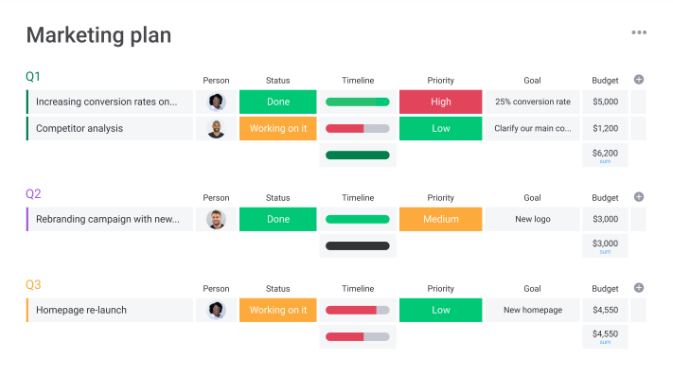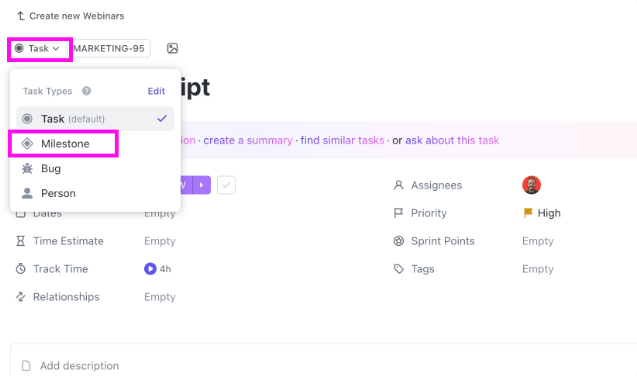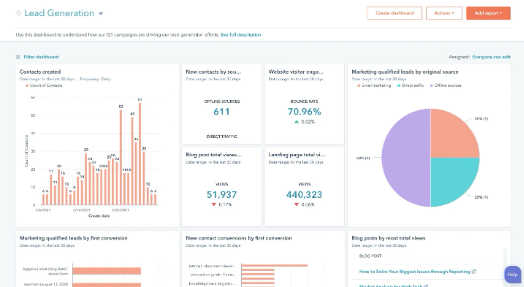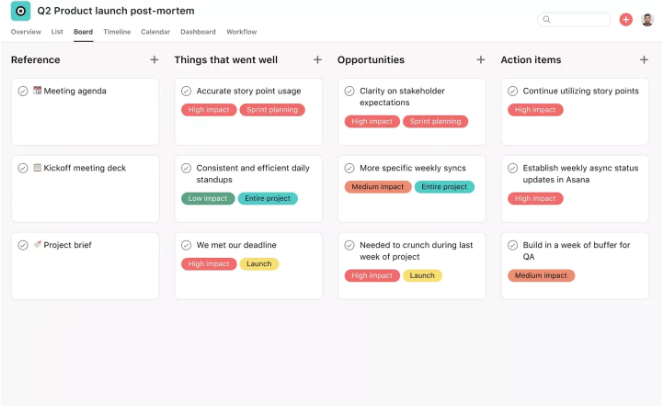Marketing project management is the GPS guiding your marketing team to success. Without a clear process for digital marketing management, it’s easy to make a wrong turn and end up in a lake of missed deadlines, frustrated teams, and unhappy clients – just ask Michael Scott of The Office.

In this article, we’ll show you why proactive project management is the key to avoiding these pitfalls, keeping your team on track, and delivering campaigns that hit your goals.
You’ll also learn how to tackle common roadblocks, like scope creep and poor scheduling, and reassess your current strategies to drive better results. But first, let’s align on what marketing project management means.
What Is Marketing Project Management?
Marketing project management is the strategic process of planning, executing, and overseeing marketing initiatives. It involves coordinating teams, tracking progress, managing resources, and keeping all stakeholders updated and aligned.
Successful marketing project management requires balancing the needs and expectations of three main groups:
- Internal Stakeholders: These include team members, departments, and leadership within the organization.
- External Stakeholders: This group may include clients, vendors, or external partners.
- Marketing Project Manager: At the center of it all is the marketing project manager (or whoever leads the project).
The marketing project manager often follows a project management framework to coordinate tasks across these groups. This framework can vary depending on goals but typically includes:
- Defined phases: Projects are broken into clear phases, such as planning, execution, and delivery, to streamline workflows, prevent scope creep, and ensure alignment with timelines and budgets.
- Specific deliverables or milestones: Deliverables refer to the output of marketing tasks, such as a completed blog, new website design, or social media strategy. Milestones mark key points where deliverables are expected to be completed, helping maintain accountability and progress tracking.
- Big-picture goals: Project managers align project tasks, resources, and deliverables with big-picture goals, such as improving brand visibility or boosting lead generation, to ensure their projects contribute to business growth.
- Project management tools: Tools and software like ClickUp, Asana, and Jira are often used to support task assignment, deadline tracking, and communication management.
Balancing the needs of internal and external stakeholders while managing resources and deadlines is key to successful marketing project management.
Why is Marketing Project Management Important?
Marketing project management isn’t just about keeping campaigns on track. It’s also important for maximizing the impact of your marketing efforts and helping your team drive real business growth.
Marketing project management supports:
- Alignment with overall business goals: Marketing project management ensures all campaigns or initiatives are designed to meet larger business objectives.
- Effective resource allocation: Businesses with strong project management practices allocate resources more efficiently, reducing wasted resources by as much as 12% (Project Management Institute, 2021).
- Realistic and achievable project timelines: Marketing project managers set clear expectations and timelines that reflect the complexity and scope of each task. This prevents burnout and increases the quality of work delivered.
- Increased team productivity: A well-organized project management framework reduces confusion and bottlenecks and provides clear direction to the team.
- Improved team alignment: Project management helps create a centralized communication system so all stakeholders stay updated, aligned, and able to collaborate to their full potential.
The 5 Key Phases of a Marketing Project
Successfully managing a marketing project requires a step-by-step approach to keep everything on track. Let’s walk through the five essential phases that form the backbone of effective marketing project management.
Phase 1: Initiation
Your project begins with the initiation phase, where you’ll set the foundation for everything else. In this phase, you’ll define the project's purpose, scope, and high-level goals.
This process typically involves identifying key stakeholders, establishing rough timelines, allocating budgets, and determining which resources are needed to move forward.
Best practices for a well-executed planning phase:
- Outline clear objectives and measurable goals to give your team a strong sense of direction.
- Identify and communicate with all stakeholders early on to maintain alignment on expectations and resources.
- Draft a high-level project brief that outlines the scope, timeline, budget, and key deliverables.
A well-executed initiation phase lays the groundwork for a successful project. It is the crucial first step that helps all team members align and move forward with a clear understanding of their roles and responsibilities.
Phase 2: Planning
The planning phase dives deeper into project development, taking your high-level project brief and developing it into a detailed project roadmap. At this stage, you focus on breaking the larger project goals into smaller, manageable chunks.
At this point, you will finalize the budget, set deadlines, and determine the tools or platforms needed for smooth execution. Planning your project like this minimizes the risk of delays or misunderstandings during the project and ensures your team has clear guidelines on what to do and when to do it.
Best practices for a productive planning phase:
- Break down large tasks into smaller, more manageable actions with clear deadlines and deliverables.
- Identify potential roadblocks or risks and develop contingency plans to avoid possible setbacks.
- Invest in project management solutions, like ClickUp or monday.com, to centralize communication, task assignment, and progress tracking.
The planning phase is essential for turning your strategy into a workable action plan. Proper planning prevents confusion and keeps the project on pace to achieve goals.

Phase 3: Execution
Your project plan comes to life in the execution phase. Teams begin carrying out the tasks laid out during the planning phase. Communication and collaboration become vital.
This phase is where the bulk of the project’s work happens. Team alignment is key at this point. As a project manager, you are the eye in the sky, overseeing this step to ensure milestones are met, quality is maintained, and any unexpected challenges are addressed.
Best practices for a smooth execution phase:
- Use project management software to monitor important project milestones. For example, in Click-Up, tasks can be converted into milestones to track critical progress points in your marketing campaign easily.
- Utilize asynchronous communication, such as email, Slack, or Loom, to encourage frequent check-ins and status updates without constant meetings.
- Use visualizations, such as Kanban boards, to improve task management and monitor project progress at a glance.
The execution phase is about lighting a fire within your marketing department and implementing your marketing campaign. Stay proactive and communicate as much as possible in this stage for a smoother campaign launch.

Phase 4: Go-live and Monitoring
The go-live phase is when the project’s deliverables are launched to your target audience. This can include publishing a campaign, launching a website, or delivering the final pitch to a client.
The project manager’s role in this stage is optimization and risk management. Project performance is monitored in real-time, most often with the help of marketing project management tools, to catch potential issues and make adjustments as necessary.
Best practices for launching and monitoring marketing campaigns:
- Be sure your team is agile and ready to make quick adjustments. Outline clear procedures that allow your team to respond to any performance issues.
- Use surveys, polls, or feedback forms to collect real-time responses from your clients or audience to identify areas for improvement.
- Run A/B tests on key campaign elements, such as ad copy, images, or calls to action, to ensure that your content is optimized for achieving project objectives.
The go-live phase is the exciting moment when your campaign is presented to the world, but it requires more than just flipping a switch. Continuous monitoring is crucial throughout the project lifecycle to maintain progress toward marketing goals.

Phase 5: Closure and Post-mortem
Finally, it’s time to wrap up your project. This closure phase marks the project's official end and is your chance to review your successes and areas for improvement.
This is the time to collect final stakeholder feedback and conduct an internal analysis of your methodologies and marketing activities. Assess how well the project aligned with objectives, how resources were managed, and how team collaboration and communication can be improved for future projects.
Best practices for an impactful post-mortem:
- Use tools like Teamwork.com to evaluate the project’s timing, budget, and team performance and generate a profitability report to measure the overall success.
- Analyze internal processes using resource management software to identify potential improvements in resource allocation, team collaboration, and communication for future projects.
- Summarize your findings and outline actionable improvements that can be made to your marketing project management process.
As Katie Yohn of Olive and Company says, “It’s especially important for team members to take something away from the meeting: whether it’s a goal to accomplish next time or a system to repeat from a standout project.”
Come together with your project team to review the project’s success. This collective reflection enhances team communication and collaboration and sets you up to excel in future projects.

How to Successfully Manage a Marketing Project
Successfully managing a marketing project requires a clear roadmap, consistent communication, and the right tools to bring it all together. Following these essential steps ensures that your project stays on track, achieves its goals, and drives the desired business results.
1. Define Your Marketing Project’s Scope, Objectives, and Goals
The first step in creating any marketing plan is to define its scope, objectives, and goals. Here, you establish what you are trying to achieve and set boundaries around what is and isn’t included in the project.
The importance of this step cannot be overstated. It sets the foundation for your project and ensures everyone is on the same page. Outlining the project scope and goals minimizes confusion and enhances team alignment, which supports smoother project execution.
When defining your project’s scope and objectives:
- Involve key stakeholders early to get their input on the project’s scope and ensure alignment with larger business objectives.
- Break down your objectives into smaller, measurable goals that help guide the team and keep the project on track.
- Document your scope and goals in a project brief that can be easily shared and referenced throughout the project lifecycle.
Defining your project's scope, objectives, and goals sets a clear direction and prevents confusion. It ensures team alignment, making project execution smoother and more efficient.
2. Define Your Success Metrics and How You’ll Track Them
To be an effective marketing project manager, you must understand what success looks like for your team. At the start of your project, outline your KPIs and success metrics to provide benchmarks to measure your performance.
Your KPIs will vary depending on your project goals but might include conversion rates, cost per lead, or cost per click. By defining these early, you can track your progress toward meeting objectives and adjust your approach if necessary.
When outlining your success metrics:
- Choose KPIs that align directly with your project goals, such as customer acquisition cost (CAC), return on ad spend (ROAS), or lead conversion rate.
- Use analytics tools like Google Analytics, HubSpot, or social media insights to track and report your success metrics in real time. Choose platforms with customizable dashboards for easier monitoring.
- Set up regular check-ins to review metrics and adjust the project if it’s not meeting expectations.
Marketing metrics act as your roadmap to success, and it’s important to choose wisely and clearly outline your tracking process. If you’re in this phase of your project, check out our guide to digital marketing analytics for more information on selecting and tracking marketing metrics.
3. Define Your Target Audience and Messaging
Without a clearly defined audience and tailored messaging, your marketing efforts can be wasted on the wrong people or completely miss the mark. In the early stages of your project, align your team on who you are targeting, their pain points, and how you can craft messages that speak to them.
When defining your target audience and messaging:
- Conduct market research to develop buyer personas and gain a detailed understanding of your target market, including key demographics, needs, and pain points.
- Prioritize personalized messaging that speaks directly to your audience’s challenges and how your solution will help them achieve their goals.
- Continuously A/B test aspects of your content marketing strategy, such as ad copy, subject lines, or graphic design, to find what resonates best with your audience.
Success can only be achieved when you understand your audience, and your messaging reflects this understanding. Take the time to research your audience, create buyer personas and target account lists, and be willing to experiment with your messaging to find what resonates best.
4. Build Your Project Plan
A solid project plan is the backbone of successful marketing project management. This step involves creating a detailed roadmap of the tasks, resources, and timelines needed to achieve your project’s goals.
Without a project plan, it can be unclear who is responsible for what, when tasks are due, and how the project will unfold. Creating a clear plan with your project team enhances accountability and keeps everyone focused on their specific tasks.
When building your project plan:
- Break down the project into tasks with assigned deadlines and responsible team members.
- Use project management tools like Trello, Monday.com, or ClickUp to visualize tasks, timelines, and dependencies.
- Identify potential bottlenecks or risks early on and develop contingency plans to avoid delays.
A well-structured project plan helps your team and provides direction for your responsibilities as a project manager. By investing time in detailed planning, you set yourself up for success as a leader while paving the way for smooth project execution.
5. Choose the Best Marketing Project Management Software
Businesses that use project management software are 31% less likely to struggle with meeting project deadlines (Project.co, 2021). This is because project management software is essential for communication, task management, and real-time progress tracking.
The best marketing project management tools improve time management, enhance collaboration, and drive efficiency. Features like customizable dashboards and real-time analytics monitoring make managing project timelines and tracking progress easier.
When choosing a marketing project management software:
- Start by identifying your needs. Consider the type of projects you’re managing, your team structure, how resources are allocated, and your project goals.
- Choose a software platform that integrates with your existing tools, such as Slack or Google Workspace, to streamline workflow.
- Look for software that offers visual task tracking, such as Kanban boards or Gantt charts, to manage timelines and task dependencies easily.
Investing in a project management tool takes a lot of pressure off your back as a project manager. These tools keep everything organized and maintain team alignment throughout the project lifecycle.
Here's the very best marketing project management software and how each supports marketing projects:
6. Assign Tasks and Project Deliverables to Your Marketing Team
Once the project plan is in place, assigning tasks and deliverables is the next step. Each team member should clearly understand their responsibilities, deadlines, and how their work fits into the larger project.
When assigning tasks and project deliverables:
- Assign tasks based on individual team members’ strengths and expertise to optimize productivity and results.
- Use project management tools to outline each team member’s responsibilities and deadlines clearly.
- Outline roles and responsibilities in a shared document that all team members can reference.
Clear task assignment drives accountability and keeps the team focused on the most important tasks. This step is critical to maintaining momentum throughout the project.
7. Launch Your Marketing Project
Next, it’s time to launch your marketing campaign. In the launch phase, marketing project managers must review all deliverables and be sure everything is in place for a successful launch.
When launching your marketing project:
- Double-check all campaign elements prior to launch. Review landing pages, ads, or email marketing processes to ensure everything is ready.
- Revisit roles and responsibilities with your team to be sure they understand their tasks once the project is live.
- Ensure your team is available to monitor the launch in real time and make any quick adjustments if necessary.
A smooth, well-timed launch can make or break a campaign. Careful preparation and monitoring are required to ensure that all elements perform as planned and deliver the expected results.
8. Monitor and Measure Campaign Results
As a marketing project manager, it’s your job to consistently monitor performance and measure campaign results. Once your campaign is live, you must be ready to adapt if something isn’t working as expected, which requires an effective analytics monitoring approach.
When monitoring and measuring your campaign results:
- Set up tracking tools like Google Analytics or HubSpot to monitor campaign performance across different channels.
- Delegate specific performance metrics to each team member for deeper insights and enhanced monitoring of KPIs.
- Review metrics such as conversions, engagement rates, and ROI regularly to gauge the project's performance.
Real-time monitoring provides insights into what’s working and what isn’t, allowing you to optimize the campaign for better results. Don’t forget to leverage your team where possible to divide monitoring tasks for better coverage.
9. Run a Post-Mortem and Repeat the Cycle
Once the project is complete, a post-mortem allows you to reflect on the successes and challenges of the campaign. This step is crucial for refining processes and ensuring even greater success in future projects.
To run an effective post-mortem:
- Hold a team meeting to review the project’s outcomes, discussing successes and improvement areas.
- Gather feedback from stakeholders to understand their perspective on the project’s performance.
- Document key lessons learned and apply them to your next project for continuous improvement.
A post-mortem helps identify what worked well and where improvements can be made, offering valuable insights that can be applied to future marketing projects.
Common Marketing Project Management Challenges and How to Prevent Them
Even with the best plans in place, marketing projects can still encounter obstacles. To set your marketing teams up for success and keep your projects running smoothly, it’s important to understand how to address the common challenges below.
1. Scope Creep
Have you ever felt like the goalposts for your project were continuously shifting? That’s scope creep, which happens when a project starts to take on more tasks, requests, or changes than originally planned.
This can be detrimental to a marketing campaign and derail the entire project. You risk missed deadlines, exhausted team members, and an end product that doesn’t meet expectations.
To prevent scope creep in your marketing projects:
- Clearly define the project scope from the start and get it approved by all stakeholders.
- Use a change management process. Any new requests go through this to evaluate if they align with the original goals.
- Regularly review the scope with the team to ensure everyone stays on track.
Stick to your original scope like glue! Regular check-ins and a formal change process will help you avoid unnecessary extras.
2. Poor Communication with Stakeholders
If communication is lacking, stakeholders might feel out of the loop, leading to frustration, lack of buy-in, and even surprise changes late in the game. Establishing clear communication guidelines limits misunderstandings and ensures all stakeholders are aligned on expectations.
To prevent communication challenges:
- Schedule regular updates with stakeholders, even if everything is going well.
- Use a marketing collaboration tool to keep all communication and progress updates in one place for transparency.
- Create a communication plan that outlines when and how updates will be delivered.
Keep stakeholders in the loop at all times. Regular updates and a solid communication plan will minimize surprises (and stress).
3. No Single Source of Truth
Without an organized documentation process, there is no single source of truth, and information silos are quick to develop. Soon, project information is scattered across emails, private chats, and different tools, leading to confusion, misalignment, and duplicated work.
To prevent information silos within your project:
- Use one central platform where all project updates, documents, and tasks are stored.
- Keep communication and file-sharing in one place using project management software like Asana, Trello, or Monday.com.
- Assign a team member to keep everything up to date and ensure everyone is using the same source for project details.
Always outline your documentation processes prior to launching a project. Keeping all info in a single source of truth saves time, confusion, and frustration.
4. Poor Project Scheduling
Poor scheduling is often the reason for project delays and missed deadlines. Without a clear project timeline, your team scrambles to finish tasks, leading to rushed or poor-quality work.
To prevent scheduling conflicts:
- Break the project into smaller tasks with clear deadlines and assign them to the right people.
- Use a scheduling tool with automated reminders to keep the team on track.
- Regularly review the schedule and adjust it if necessary to accommodate any changes.
A good schedule is the backbone of any project. To stay on course, break tasks into manageable chunks and review the timeline often.
Marketing Success is Built on Solid Project Management
Effective marketing project management is the foundation for achieving your campaign’s goals and ensuring smooth execution from start to finish.
You can avoid common pitfalls like scope creep and poor communication by clearly defining your project’s scope, aligning your team, and using the right tools to track progress and performance.
A structured approach enhances productivity and leads to better collaboration and results. Remember, the key to marketing success is careful planning, real-time monitoring, and continuous improvement after each project cycle.
Join For More Digital Marketing Management Insights
Ready to grow? Subscribe to The CMO newsletter to stay on top of trends and get the latest tips, resources, and guides from our community of seasoned marketing leaders straight to your inbox.



